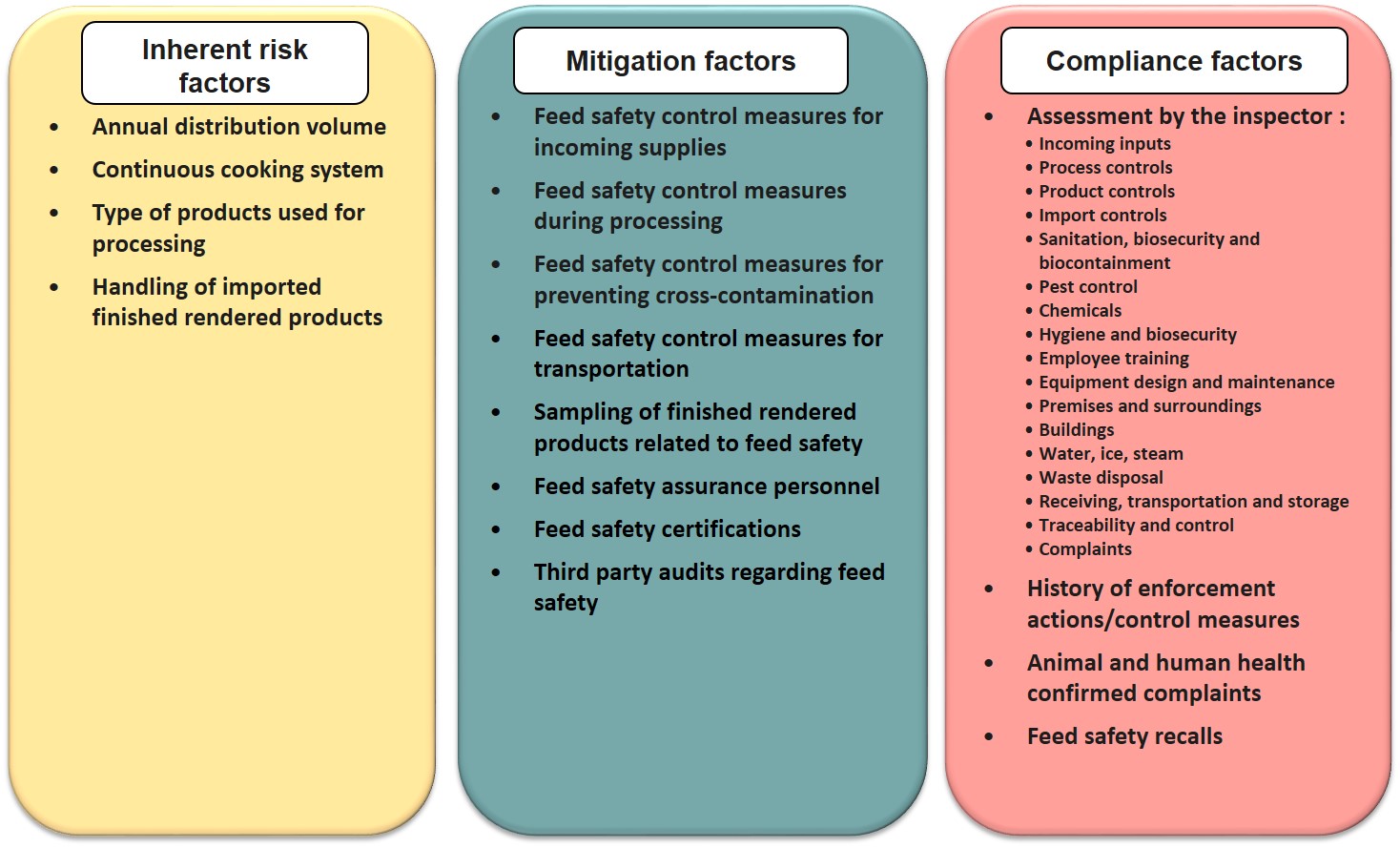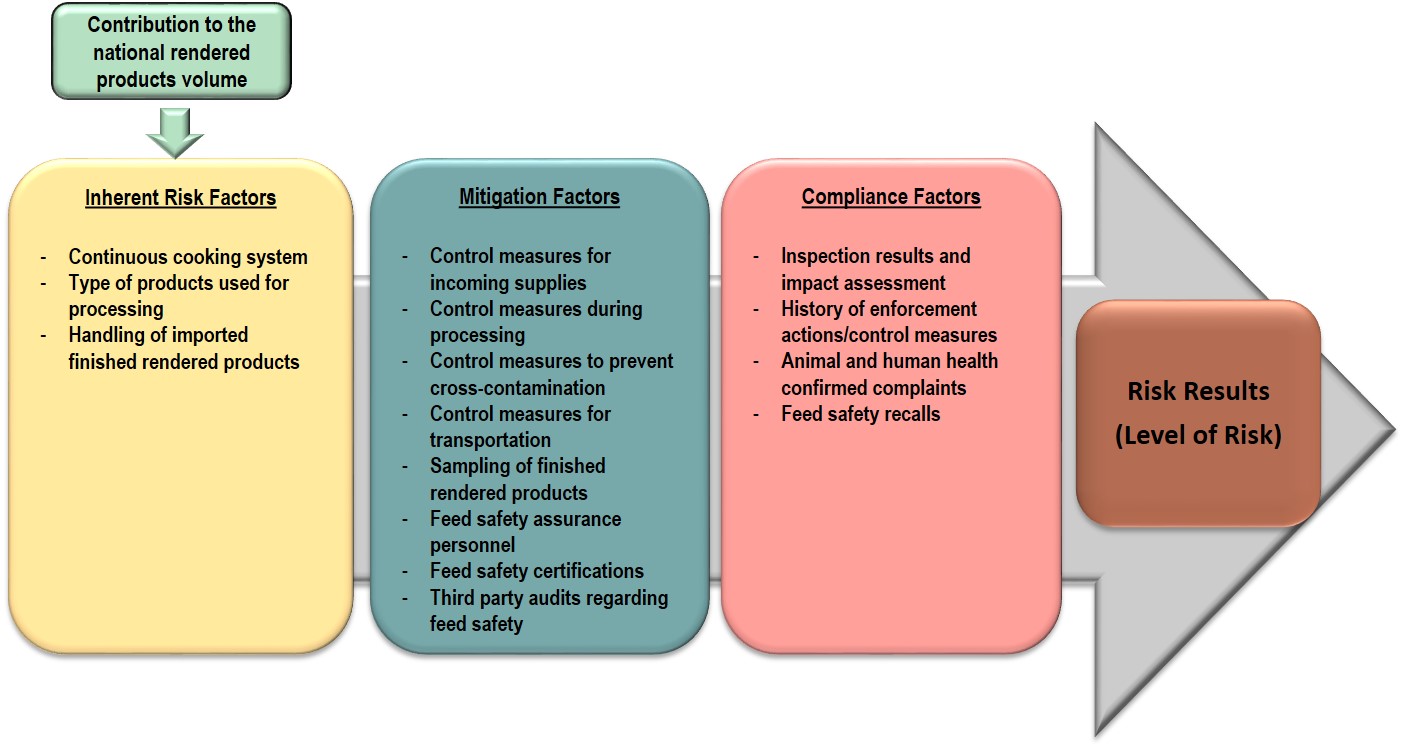The risks to food safety and our animal and plant resources have changed considerably in recent years and continue to change rapidly. At the same time, the Canadian industry has to be more efficient and innovative to compete in a global economy. In this context, the Canadian Food Inspection Agency (CFIA) began to evolve the way it manages risks, supports industry's ability to compete globally, and embraces technology to provide more efficient and responsive services.
The CFIA committed to better use its data, reports and surveillance information to find unusual trends related to its mandate. This allows the agency to focus on risk and support program design, planning, compliance and enforcement efforts. In support of agency priorities, the CFIA developed an Establishment-based Risk Assessment model for renderers (ERA-Renderer) to allocate inspection resources based on feed safety risks. This risk assessment model will be used to determine the level of oversight needed to manage the risks. The ERA-Renderer model was developed by the CFIA in collaboration with experts from academia and industry. The development of the model drew on the experience acquired while developing the ERA-Food (for domestic food establishments), the ERA-Hatchery and the ERA-Feed Mill models.
The ERA-Renderer model comprises 3 different groups of risk factors:
- inherent risk factors
- mitigation factors
- compliance factors
A questionnaire was designed to collect data for the first 2 components; an online tool linked with the permission process is also being planned. Data on compliance factors are extracted from the CFIA databases.
After a cycle of data collection and analysis by the ERA-Renderer model, the risk results will provide input into the agency's risk-informed approach to manage feed safety risks. This includes the prioritization of inspection, oversight strategies and priorities, and work planning.
The scientific approach used to develop the ERA-Renderer model since 2019 and its practical application are presented below. Annex 1 presents the scientific advisory committee members and technical working group members involved in the ERA-Renderer model development.
Scientific approach and applied use
- Identification of factors associated with feed safety risk
- Selection of risk factors for the ERA-Renderer model
- Risk factors' criteria weighting for the ERA-Renderer model
- Design of the ERA-Renderer model
- National data collection in rendering plants
- Performance assessment of the ERA-Renderer model outputs
Identification of factors associated with feed safety risk
The goal was to find the most meaningful feed safety risk factors that could be used in a risk assessment model for rendering plants. Several chemical and biological hazards such as dioxins and Salmonella spp. were considered. A review of the scientific literature and advice from an expert panel were used to develop a comprehensive list of risk factors that could contribute to the feed safety risk attributed to Canadian rendering plants processing raw animal by-products and/or recycled fats from animals to produce protein meals and fats intended for livestock.
Selection of risk factors for the Establishment-based Risk Assessment model for renderers
For a quantitative risk assessment model, a limited number of risk factors are needed. Other criteria were considered to select risk factors, such as:
- the clarity of their definition
- the merging of risk factors sharing similar concepts
- the inclusion of only measurable risk factors (for example the probability that this factor can be objectively assessed during an inspection process)
- the availability of data sources
- the ability of the factors to differentiate the risk between establishments (discriminatory power)
The final list of risk factors is presented in figure 1. A scientific paper describing the process followed for the identification and selection of risk factors and criteria is currently being prepared for submission in a peer-reviewed journal. Briefly, risk factors were grouped into inherent risk factors, mitigation factors and compliance factors.
Inherent risk factors represent those associated with a specific type of product, operation or process. These factors take into account:
- the type of products being processed by the rendering plant (for example, specified risk material, prohibited materials)
- practices such as using a continuous cooking system
- the volume of production
Mitigation factors are the measures or strategies that a rendering plant uses to reduce the inherent risk, beyond mitigation procedures required by regulations. They are implemented by the industry to reduce the risk of contamination of the livestock and food products derived from these animals such as meat, milk or eggs. Examples of these strategies include:
- controlling the safety of incoming supplies through on-site audits of suppliers
- feed safety control measures used during transportation, such as using or requiring dedicated conveyances for different types of rendered finished products
- having an implemented and certified feed safety assurance program
Compliance factors refer to a rendering plant's track record with respect to how well it has complied with regulatory requirements. This is assessed using the rendering plant's historical and current compliance data such as information on inspection results, history of enforcement and control actions, complaints related to feed safety and recalls. The elements shown under the inspector assessment is the list of preventive control plan (PCP) sub-elements that the ERA-Renderer model should consider under the Integrated Agency Inspection Model (iAIM).

Description for List of risk factors included in the ERA-Renderer model
This figure illustrates the list of risk factors included in the ERA-Renderer model. The first box represents the inherent risk factors which are those associated with specific types of rendering plants and processes. Included in this group of risk factors:
- the annual distribution volume
- using a continuous cooking system
- the type of products used for processing
- handling of imported finished rendered products
The second box represents the mitigation factors which are the measures or strategies that a rendering plant has implemented to control the inherent risks and to reduce the overall risk of a feed safety issue. Mitigation factors include:
- control measures for incoming supplies
- control measures during processing
- control measures to prevent cross-contamination
- control measures for transportation
- sampling of finished rendered products
- feed safety assurance personnel
- feed safety certifications
- third party audits regarding feed safety
The third box represents the compliance factors which refer to a rendering plant's track record on how well it has complied with regulatory requirements. Compliance factors are assessed using:
- inspection results and impact assessment of non-compliances
- history of enforcement and control actions
- animal and human health confirmed complaints
- recalls related to feed safety
The list under the inspector assessment is the list of preventive control plan (PCP) sub-elements that the ERA-Renderer model should consider under the Integrated Agency Inspection Model (iAIM), that are:
- incoming inputs
- process controls
- product controls
- import controls
- sanitation, biosecurity and biocontainment
- pest control
- chemicals
- hygiene and biosecurity
- employee training
- equipment design and maintenance
- premises and surroundings
- buildings
- water, ice, steam
- waste disposal
- receiving, transportation and storage
- traceability and control
- complaints
Risk factors' criteria weighting for the Establishment-based Risk Assessment model for renderers
The goal was to estimate the relative importance of selected criteria used to measure the risk factors included in the ERA-Renderer model based on their impact on feed safety. In June 2021, 177 criteria were presented to 20 Canadian experts during a 2-round expert elicitation to estimate their relative risk in regards to feed safety. There was broad consensus among participating experts on the relative risk given to the various criteria. Respondents' professional profile did not have an influence on the results. Median values for each criterion were used to build the ERA-Renderer model algorithm.
Design of the Establishment-based Risk Assessment model algorithm for renderers
The volume contribution of each rendering plant to the national rendered products volume is first calculated. The algorithm then considers the presence or absence of specific feed safety criteria and their relative risk to adjust the level of risk of each rendering plant (figure 2).

Description for Illustration of the ERA-Renderer model algorithm
This figure illustrates the model design as an arrow. First, the contribution of a rendering plant to the total volume of rendered products distributed in Canada is considered. Then, the relative risk is calculated by considering the assessment criteria applicable to a specific rendering plant for each cluster: the inherent risk factors, the mitigation factors, and the compliance factors represented by the first, second and third boxes, respectively. This calculation generates the risk result at the rendering plant level represented by the last box.
Inherent risk factors take into account:
- using a continuous cooking system
- the type of products used for processing
- handling of imported finished rendered products
Mitigation factors include:
- control measures for incoming supplies
- control measures during processing
- control measures to prevent cross-contamination
- control measures for transportation
- sampling of finished rendered products
- feed safety assurance personnel
- feed safety certifications
- third party audits regarding feed safety
Lastly, compliance factors are assessed using:
- inspection results and impact assessment
- history of enforcement and control actions
- animal and human health confirmed complaints
- recalls related to feed safety
National data collection in rendering plants
At this step, data on inherent and mitigation factors applicable to each rendering plant are collected using a questionnaire. This information is added to the data on compliance factors available in the CFIA databases in order to assess the risk of each rendering plant. This step will also enable the validation of the data collection tool and supporting documents. An online national data collection for all inedible rendering plants throughout Canada is planned for fall 2021.
Performance assessment of the Establishment-based Risk Assessment model outputs for renderers
The objectives of this step are to estimate the agreement between the risk assessment results provided by the ERA-Renderer model and the CFIA senior inspectors, and to refine the model based on the identification of major discrepancies. To do so, a random selection among completed questionnaires from the national data collection will be done. This exercise is planned for winter 2022.
Once these steps are completed, the risk results generated by the national data collection will be used for inspection planning and will provide input into the agency's risk-informed approach to managing feed safety risks.
The Establishment-based Risk Assessment model for food establishments (ERA-Food) was developed following the same scientific approach. This approach was used to develop the Establishment-based Risk Assessment model for hatcheries (ERA-Hatchery) and the Establishment-based Risk Assessment model for feed mills (ERA-Feed Mill). The ERA technical working group is also currently adapting the ERA model for food importers (Importer Risk Assessment model).
Annex 1 – The scientific advisory committee members and the technical working group for the Establishment-based Risk Assessment model for renderers (as of June 2021)
| Name | Affiliation |
|---|---|
| Sylvain Quessy, chief scientist | Université de Montréal |
| John Smillie | Formerly with Canadian Feed Research Centre, University of Saskatchewan |
| Rick Holley | University of Manitoba |
| Egan Brockhoff | Canadian Pork Council |
| My-Lien Bosch | Animal Nutrition Association of Canada |
| Djillali Kashi | Canadian Renderers Association |
| Philip Snelgrove | Canadian Food Inspection Agency |
| Name | Affiliation |
|---|---|
| Manon Racicot | Canadian Food Inspection Agency |
| Romina Zanabria | Canadian Food Inspection Agency |
| Geneviève Comeau | Canadian Food Inspection Agency |
| Virginie Lachapelle | Canadian Food Inspection Agency |
| Alexandre Leroux | Canadian Food Inspection Agency |
| Jennifer Kormos | Canadian Food Inspection Agency |
| Eric T. Ward-Bellehumeur | Canadian Food Inspection Agency |
| Tony Van Vonderen | Canadian Food Inspection Agency |
| Stéphanie Dubeau | Canadian Food Inspection Agency |
| Marie-Lou Gaucher | Université de Montréal |
| Marcio Costa Carvalho | Université de Montréal |
| Younès Chorfi | Université de Montréal |
| Mohamed Rhouma | Université de Montréal |